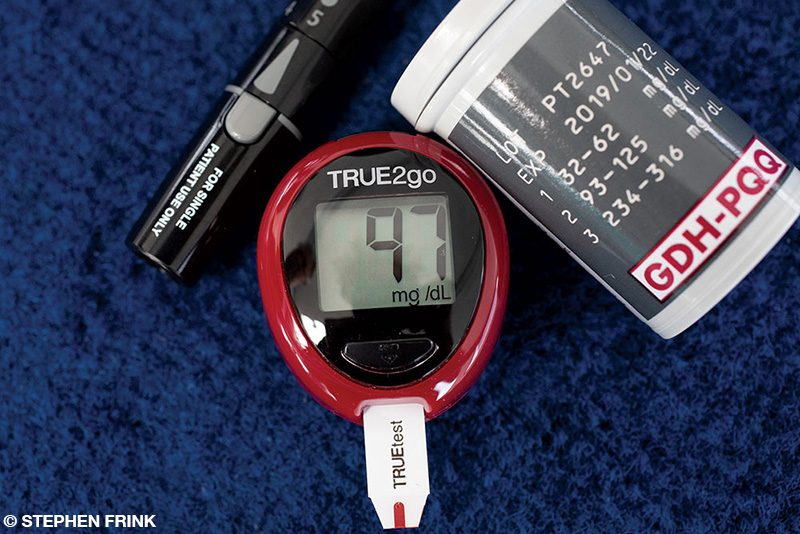Are scuba instructors well-informed?
As a scuba instructor, I see more and more students who have diabetes. While DAN® and others have published research on diving with Type 1 and Type 2 diabetes, many dive instructors are either misinformed or not informed at all when it comes to teaching these students. To address this major information gap and safely dive with people who have diabetes, we must educate ourselves.
What Is Diabetes?
A person’s normal fasting blood glucose is less than 100 milligrams per deciliter (mg/dL). Diabetes is a fasting blood glucose level greater than 126 mg/dL or a nonfasting blood glucose level of more than 200 mg/dL on a random test or an oral glucose tolerance test. For healthy individuals, the body responds normally to keep blood glucose within 70 to 99 mg/dL. For people with diabetes, the body does not respond properly to maintain blood glucose levels because of either the body not producing insulin (Type 1 diabetes) or the body not responding properly to the insulin it produces (Type 2 diabetes). Thus, treatment for diabetes is a battle between reducing glucose out of the hyperglycemic range while trying to simultaneously avoid hypoglycemia.
Diabetes is no longer an automatic disqualifier for diving, but people with diabetes will need a doctor’s permission to dive. Precautions are necessary to help deal with the potential for both hyperglycemic and hypoglycemic events that could occur while diving. Consultation with a doctor will help the diver learn what to expect and how to manage these events.

What Is Hypoglycemia?
Hypoglycemia is an abnormally low blood glucose level that may endanger life. It is hard to define as a number, but typically it is when glucose drops below 70 mg/dL. People are different in how their bodies respond to glucose levels, however, and warning signs may not appear until much lower glucose levels. Signs and symptoms of hypoglycemia may include fatigue, shakiness, dizziness and hunger, among other symptoms, and if not corrected can lead to confusion, seizures or even death. I conduct diabetes research that focuses on hypoglycemia, so I know very well how dangerous it is for a person to have low glucose levels. (Please note that I am not a medical doctor and am not giving medical advice.) Hypoglycemia while underwater could be especially dangerous: A seizure underwater could cause divers to lose their regulators, or confusion could lead to diver error and increase the risk of decompression illness.
Scuba Diving with Diabetes
There is a lot of research about exercise-induced hypoglycemia. Divers are not only exercising, but they also have the added effects of temperature and pressure changes. As with research conducted on individuals doing exercise on land, research on the effects of glucose while diving has been mixed depending on the individuals, their medications and type of diabetes.
Years ago I had a dive buddy with Type 2 diabetes, and it was interesting to watch his glucose patterns over time. The more he dived, the more he learned about his levels. He realized that his glucose could drop by up to 100 points on each dive. Knowing this, he would carefully manage his glucose level prior to diving. Blood glucose should be at or greater than 150 mg/dL and stable or rising on a minimum of three tests before entering the water. If a test results in lower than 150 mg/dL or higher than 300 mg/dL, then the person should delay diving.
For More Information
Read DAN’s recommended protocols for diving with diabetes in the resource Guidelines for Diabetes and Recreational Diving.
Every person is different. Not all divers with diabetes will have hypoglycemia, but they should still consult with their physicians about their needs and abilities to dive. Maintaining an accurate dive log that includes glucose levels before and after dives is important for learning more about personal responses to diving over time. Limit dive time to one hour, and avoid depths greater than 100 feet, overhead environments, the need for mandatory decompression stops and any other situations that could exacerbate hypoglycemia.
If you have diabetes, it’s important to inform your dive leader and buddy (who should not be diabetic) about your condition and make sure they are aware of what to do and are ready to assist should your glucose levels drop.
Scuba Instructors
I recently taught my first dive student with Type 2 diabetes. I told him that although research suggests that glucose will not fluctuate much, it is possible that levels could drop into the hypoglycemic range, of which he was unaware. He said he was grateful to have me as an instructor, because otherwise he may not have known to prepare for hypoglycemia. He began to monitor his glucose around diving and make sure he had a glucose source at the dive site. His glucose dropped by 50 points on average each time he dived, even in the 12-foot-deep pool.
Most of the other instructors at my dive shop were surprised that glucose could drop so low during a dive for someone with diabetes. Numerous scuba instructors probably have students with diabetes and do not know to suggest that they carry with them to the dive site emergency glucose in the form of pill, food, drink or medicine to assist with a potential hypoglycemic episode. An informed instructor can help encourage glucose monitoring and proper hydration as well as teach divers with and without diabetes how to recognize and respond to a hypoglycemic-related problem.
With the ever-increasing rates of diabetes in the world, it is important for scuba instructors and dive buddies of people with diabetes to learn about the risks and how to properly pack an emergency kit for those divers. As buddies and instructors, we should educate ourselves so we can be ready to help divers with diabetes safely enjoy their dives.
For More Information
See DAN’s complete guidelines for diving and diabetes at DAN.org/research/scientific-summaries/diabetes-diving.html.
© Alert Diver — Q3 Summer 2019